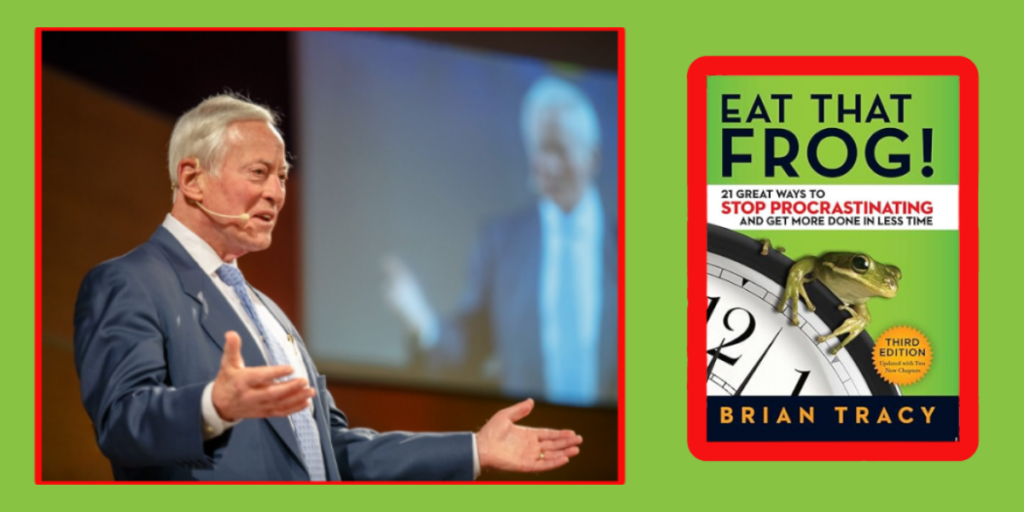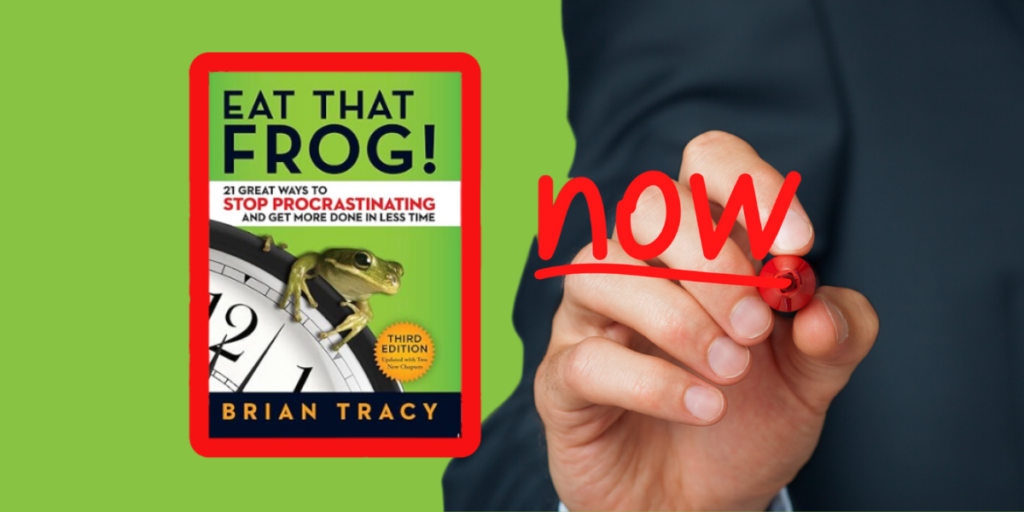Procrastination is the ultimate productivity killer.
In the chaotic marketplace of daily life, where the relentless hustle never seems to ease, there’s a rather peculiar nugget of wisdom that’ll make your mornings a lot more palatable – eat the frog.
Now, I’m not talking about some bizarre breakfast menu from a French café.
No, no.
This is pure Brian Tracy – author, thinker, and master of the “get-it-done” brigade.
Eat That Frog! is his magnum opus, where he urges us all to gulp down the ugliest, nastiest task first thing in the morning. Because, let’s face it, if you start your day with a metaphorical amphibian, everything else will seem like a delightful stroll in the park.
See, here’s the deal: that “frog” represents the one looming, monumental task that will make the biggest difference to your day, your life, and, yes, your bank account. It’s the thing you avoid, the task you dodge. But, like all wise investments, facing it head-on early in the day gives you the greatest return.
You don’t dilly-dally with trivial nonsense; you dive into the deep end, swim with the sharks, and come out holding a golden chalice of productivity in one hand and a hefty sense of accomplishment in the other.
In this article, we’ll explore seven proven strategies that echo Tracy’s principles while adding new insights to help you conquer procrastination. Whether you’re working on a business project, prepping for a big presentation, or just trying to clean out your inbox, these tips will help you prioritize, focus, and ultimately, get things done. So, ready to take a bite out of your to-do list?
Let’s dig into the key strategies that will have you eating frogs like a productivity pro.

Brian Tracy is a renowned motivational speaker, author, and productivity expert, best known for his teachings on personal development, goal setting, and effective time management strategies.
Strategy 1: Prioritize Your Tasks Using Tracy’s ABCDE Method
Brian Tracy’s ABCDE method is like having a GPS for your to-do list.
Instead of letting tasks overwhelm you, this method allows you to categorize them by importance and urgency. “A” tasks are your frogs—the big, ugly things you’ve been dreading but must complete to make meaningful progress. On the other hand, “E” tasks are the distractions—minor chores that don’t add much value and can easily wait. By structuring your day using the ABCDE method, you ensure that you’re not just being busy, but productive.
Start your day by identifying one “A” task that will have the biggest impact on your goals.
This could be a project deadline, a crucial client call, or that report you’ve been putting off for weeks. Once you’ve got your frog in sight, the goal is to eat it—no excuses. Remember, tackling your most difficult tasks first means you’re setting yourself up for success, rather than scrambling to complete smaller, less important ones.
Why does this work? Simple. Prioritization helps reduce decision fatigue. When you have a clear plan of attack, you’re less likely to procrastinate or get distracted by trivial tasks. Plus, the feeling of accomplishment after handling an “A” task gives you the momentum to power through the rest of your day.
Strategy 2: Use Time Blocks to Stay Focused
Time blocking is the productivity secret sauce for those who struggle with distractions. The principle is simple: allocate specific chunks of your day to work on particular tasks, and during those blocks, focus solely on that task.
Brian Tracy champions the idea of “single-handling” every task, meaning you give each one your full attention until it’s completed.
Multitasking is productivity’s worst enemy, and time blocks help you avoid that trap.
To get started, take a look at your to-do list and break your day into focused time slots. For example, you could dedicate an hour in the morning to eat your frog (aka the big, important task). During this time, turn off email notifications, put your phone on “Do Not Disturb,” and close unnecessary browser tabs. The goal is to eliminate distractions and be fully immersed in what you’re doing.
Tracy believes that the ability to focus single-mindedly on your highest-value tasks is a crucial determinant of success.
By sticking to time blocks, you train your brain to focus for sustained periods. You’ll be amazed at how much more you can get done when you’re not constantly switching between tasks. And remember, don’t be afraid to schedule breaks. A 5-minute breather after each time block can keep you energized and mentally sharp throughout the day.
Strategy 3: Set Daily Goals for Productivity
Setting daily goals might sound obvious, but Brian Tracy takes it one step further by encouraging you to “put the pressure on yourself.” This means holding yourself accountable to achieve what you’ve set out to do, even if no one else is watching. The beauty of daily goals lies in their simplicity. Rather than focusing on long-term, overwhelming objectives, you break them down into bite-sized tasks that you can tackle today. It’s like eating the frog one bite at a time.
Start by jotting down three to five essential tasks you want to accomplish today. These should be specific and realistic, allowing you to track your progress and stay motivated. Tracy argues that when you set daily goals, you create a sense of urgency, which pushes you to work smarter, not harder. Whether it’s responding to important emails, finishing a draft of a report, or preparing for a meeting, your daily goals act as a roadmap for a productive day.
But here’s the kicker: each time you tick off a goal, you’ll feel a rush of accomplishment, making it easier to tackle the next task. This momentum builds throughout the day, leading to more productivity and less procrastination. And at the end of the day, you can review your progress, reflecting on what worked and what didn’t, so you can improve tomorrow.
Strategy 4: Break Tasks Into Manageable Steps
Ever stared at a massive task and thought, “I have no idea where to start”? You’re not alone. But Brian Tracy offers a simple yet effective solution: slice and dice your tasks. By breaking down large projects into smaller, manageable steps, you make the task less intimidating and more achievable. It’s the equivalent of cutting your frog into bite-sized pieces, making it easier to digest.
For instance, if your frog is “Write a 20-page report,” that’s a daunting prospect.
But if you break it down into smaller steps like “Outline the main sections,” “Research data points,” and “Draft the introduction,” suddenly it becomes much more manageable. Each step you complete brings you closer to the finish line without overwhelming you.
This strategy also taps into the psychology of small wins. Every time you complete a step, no matter how minor, you experience a boost in motivation and confidence. Before you know it, you’ve eaten the frog without even realizing it.
So, next time you’re faced with a colossal task, remember: slice, dice, and conquer.
Strategy 5: Upgrade Key Skills to Work More Efficiently
Procrastination often stems from a lack of confidence or feeling ill-equipped to handle a task.
That’s where Brian Tracy’s principle of upgrading key skills comes in. The more competent and skilled you are, the easier it is to tackle your frogs with confidence. Whether it’s improving your writing skills, learning how to use new software, or becoming a better communicator, continual skill development is essential for boosting productivity.
Start by identifying the skills that would make the biggest difference in your work.
Maybe you need to learn a new project management tool to streamline your tasks or improve your public speaking skills for presentations. Once you’ve pinpointed the skills, dedicate time each week to working on them. As you improve, you’ll find that tasks that once felt difficult or time-consuming now take a fraction of the time.
Investing in yourself isn’t just about getting ahead; it’s about making your day-to-day tasks easier and more efficient. When you’re confident in your abilities, procrastination doesn’t stand a chance.
Strategy 6: Tackle Tasks with Peak Energy
Everyone has a time of day when they’re most productive—when the brain is sharp, and energy levels are high. For many, this is in the morning, but it could vary depending on your personal rhythm.
Brian Tracy emphasizes the importance of tackling your most challenging tasks during this peak energy period. Why? Because if you try to eat your frog when you’re running on fumes, you’re more likely to procrastinate or do a subpar job.
To harness your peak energy, plan your day around it.
If you know you’re most alert in the morning, schedule your frog for that time. Save less demanding tasks, like answering emails or attending meetings, for when your energy naturally dips. By aligning your hardest tasks with your best mental state, you’re setting yourself up for success.
This strategy ensures you’re working with your body’s natural rhythm, not against it. And when you handle your frogs with peak energy, you’ll be more efficient, make fewer mistakes, and feel less exhausted by the end of the day.
Strategy 7: Review Your Progress and Reflect
Last but not least, let’s talk about reflection.
Brian Tracy advocates for regular reviews of your progress to keep you on track. This means taking a step back, looking at what you’ve accomplished, and adjusting your strategy if necessary. Reflection isn’t just about patting yourself on the back for a job well done; it’s about identifying areas where you can improve and setting yourself up for even more success.
At the end of each day, take a few minutes to review what you accomplished.
Did you eat your frog? If not, what got in the way?
This simple exercise of reflection and review can help you refine your strategies and improve your productivity over time. Tracy emphasizes that self-discipline and self-awareness are critical components of success, and regular reflection is how you build both.
By reflecting regularly, you develop a keen sense of what works for you and what doesn’t, allowing you to optimize your approach to productivity. Plus, there’s something deeply satisfying about tracking your progress and seeing how far you’ve come.
Start Eating Your Frogs Today
Now that you’ve got these seven proven strategies in your toolkit, it’s time to put them into action.
Brian Tracy’s Eat That Frog has become a productivity classic for a reason—it works.
By tackling your hardest tasks first, prioritizing effectively, and staying focused, you can beat procrastination and boost your productivity.
So, what’s your frog for tomorrow?
Write it down, and make it the first thing you tackle when the day begins. The feeling of accomplishment that follows will set the tone for a productive, efficient, and stress-free day. After all, when you start with the worst, everything else seems easy. Happy frog eating!
Hear It From Brian
Be sure to subscribe to our YouTube channel for more free AI-themed resources, and tools designed to empower your knowledge-building journey. Whether you’re wrapping your head around the future of jobs or exploring cutting-edge AI insights, we’re here to help you grow.
Ready to level up your success? Dive into our Six Pillars of Wealth and discover how to integrate these principles, along with AI-driven strategies, into your overall wealth plan.
Don’t miss our other articles on financial education, mindset training, and the advantages of AI and having a money mentor to boost your financial knowledge.

